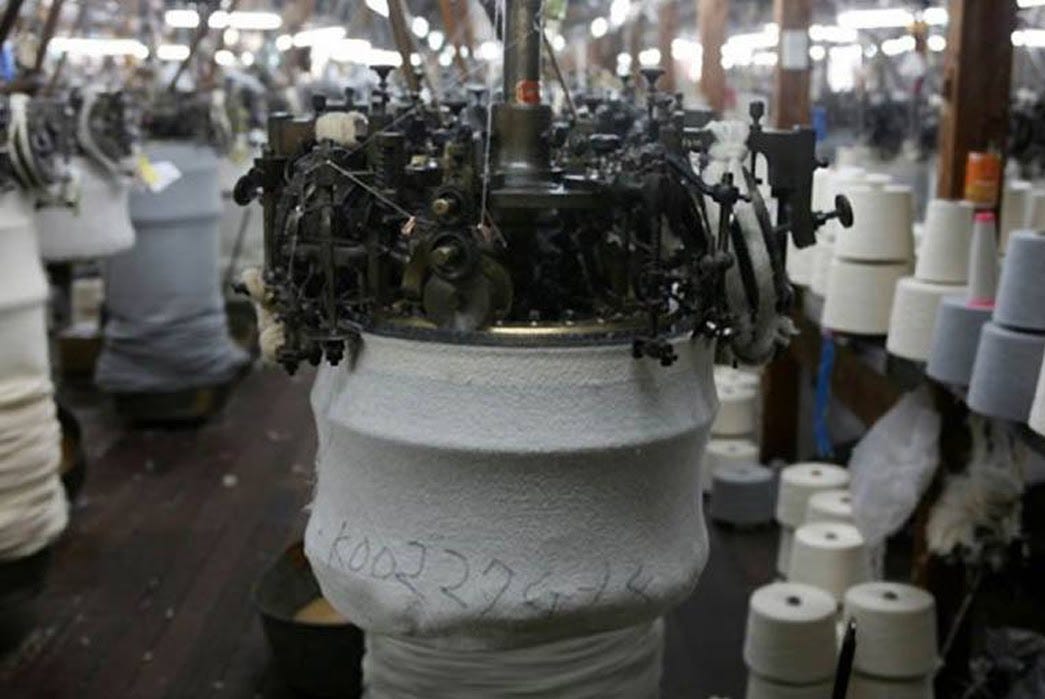Why is this interesting? - The Loopwheeler Editon
On old looms, the beauty of inefficiency, and sweatshirts
Colin here. Despite significant changes in manufacturing technology, sometimes, tried and true machines turn out the best product. Today, most denim is manufactured on computer-controlled looms. The precision and efficiency are there. The character, not so much. So aficionados often turn to jeans that were made from old-school looms.
One of the last of these factories in the US was North Carolina’s White Oak plant. There they produced one of the most unique types of denim you could find on the market. Here’s how Craftsmanship Quarterly described it in 2017:
Today, as you walk through White Oak’s cavernous weave room, where technicians and robotic arms rove among long rows of electronic looms, long-chain dye units, “slashers,” and other modern textile machinery, at a certain point you see the flooring change from concrete to old wooden planks. Resting on those planks are 51 mechanical power looms, all made in the 1940s and all painted green, loudly clacking away like oversize manual typewriters.
These machines were made by the now defunct Draper Corporation of Hopedale, Massachusetts, and this particular model, the Draper X3, represents the last generation of “fly shuttle” looms that America ever made. The period authenticity in this room is more than aesthetic; the vibrations of the Drapers bouncing on the wooden floor provide White Oak denim’s unique terroir. The plant’s signature is in every swath of denim it makes, like cursive vibrations written in weft yarn.
Unfortunately, there wasn’t enough demand to keep up with the cost of keeping these huge machines running and the White Oak plan shut its doors at the end of that year.
Why is this interesting?
Just as a wine’s flavor profile is based on the climate and soil conditions, this fabric had a “terroir” of sorts, based on its manufacturing origin. As these machines are replaced with more efficient ones, the materials they created are once again prized and in-demand.
Another vivid example of this process is Loopwheeler, a Japanese brand who makes what discerning fans call the “best sweatshirt in the world.” According to a 2015 post by ACL: “There on the southeastern coast of Japan you’ll find the Loopwheeler factory, one of the last bastions of Wakayama’s once robust manufacturing industry. Along with Merz B. Schwanen in the Swabian Mountains of Germany, Loopwheeler is one of the only remaining two factories producing authentic loopwheel terry cloth in the world.”

It is the deliberately slow process that yields incredible, iconic results, that people are prizing and searching on sites like Grailed and other aftermarket spots. Part of the appeal is the texture, but another benefit is the longevity: the quality of the fabric far outweighs what you can buy commercially today, and also means that these garments soften and improve with age, developing a patina of sorts. ACL continues:
For most companies, their success is determined by how well they can adapt to a changing marketplace, but it’s Loopwheeler’s reluctance to change anything which has made their product so extraordinary. The loopwheel process was developed by Italian inventor Guiseppe Negra back in 1926, using machines which rotate around cylinders at an incredibly slow rate to create layer after layer of cotton. These machines can only complete twenty-four rotations per minute, meaning it takes an hour to produce just one meter of loopwheeled terry. All that time and effort is well worth it though because the resulting fabric is remarkably durable. Negra licensed the loopwheel process out to companies like L.L. Bean and Champion, which is why vintage American sweatshirts from this era are so desirable to this day.
While the resulting product is first-rate, the loopwheel process itself was just too slow for these rapidly scaling companies and in the mid-century they all traded up to faster, side-seam manufacturing for their knits. Loopwheeler in Japan never got around to modernizing though, not because they recognized how special the loopwheel process was, but because they simply couldn’t afford to invest in costly new technologies.
While a lot of fashion culture today is about rare drops and manufactured scarcity, there’s something novel in luxury coming from true production constraints. This fabric can only be produced one meter per hour, in a process known as “tsuriami-ki” which relies on the force of gravity. A Loopwheeler sweatshirt I procured is interestingly deceiving. At first, you see a garment that looks about as ordinary as plain day. But on further examination, the painstaking weaving process is revealed in the inside layer of the garment: it is dense yet soft and lasts a long, long time. (CJN)
Tote of the Day:
Ghostly is one of our favorite record labels, and its founder, Sam Valenti, has written a few great WITIs in his day. In addition to putting out great albums, their merch is also on point. This tote caught my eye, particularly the visual identity in collaboration with Actual Source. (CJN)

Quick Links:
Virtual rate cut forces Nintendo gamers into riskier assets (NRB)
Why China’s smaller businesses are struggling to get credit (CJN)
Thanks for reading,
Noah (NRB) & Colin (CJN)
—
Why is this interesting? is a daily email from Noah Brier & Colin Nagy (and friends!) about interesting things. If you’ve enjoyed this edition, please consider forwarding it to a friend. If you’re reading it for the first time, consider subscribing (it’s free!).


